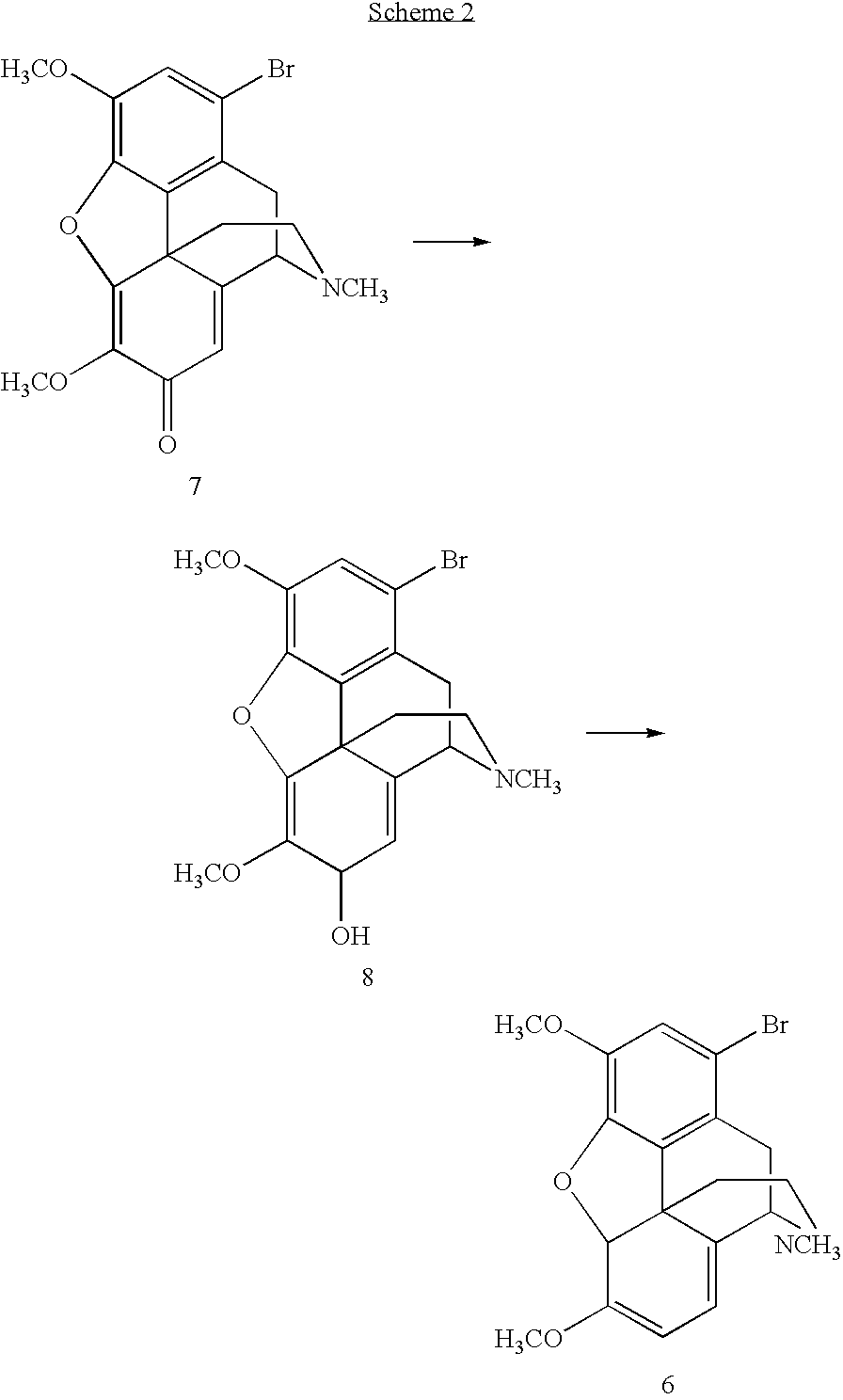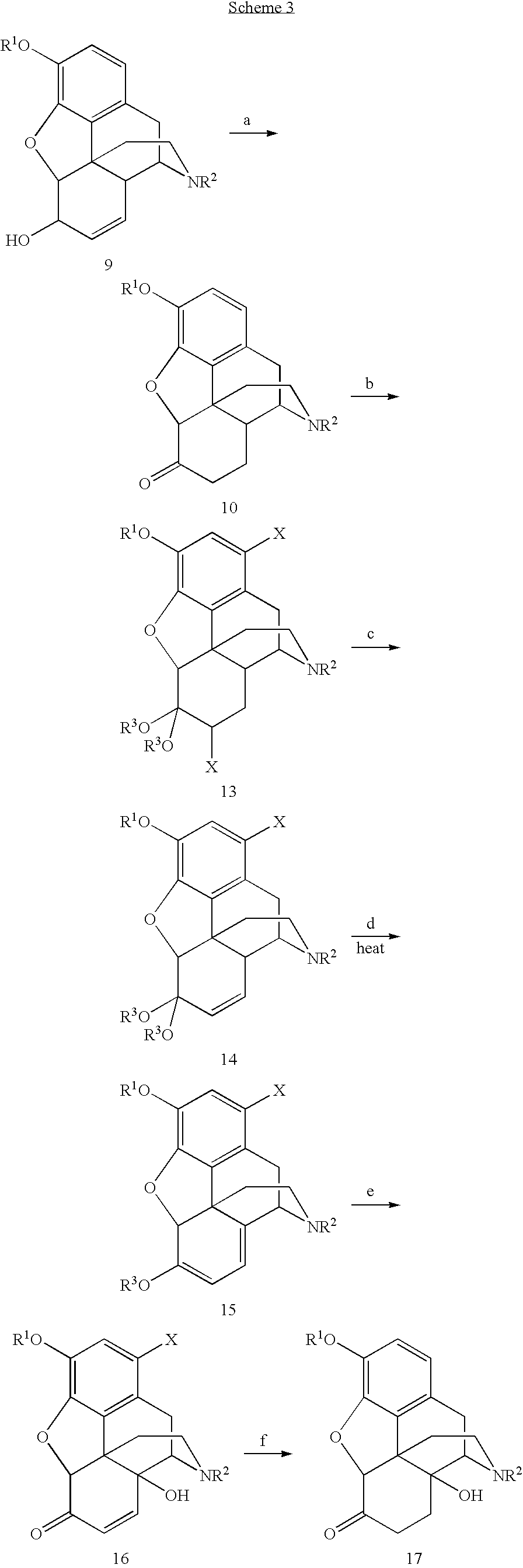Synthetic Route to 14-Hydroxyl Opiates Through 1-Halo-Thebaine or Analogs
a technology of opiate and synthesis method, which is applied in the field of producing 14 hydroxylopiates through 1halonorthebaine derivatives, can solve the problems of poor reproducibility, high cost and inefficiency of multi-step synthetic methods, and low yield, and achieves the effect of convenient scaling up and economical manufacturing purposes
- Summary
- Abstract
- Description
- Claims
- Application Information
AI Technical Summary
Benefits of technology
Problems solved by technology
Method used
Image
Examples
example 1
[0046]To a 1000 mL three-necked flask, MeOH (250 mL) was added. Codeine (62.5 g, 0.209 mol) was added and stirred until completely dissolved. The solution was flushed with nitrogen over a 10 minute period. Wilkenson's catalyst, Rh(PPh3)3Cl, (0.625 g) was added under nitrogen. The solution was refluxed for 3 h to give a suspension. MeOH (125 mL) was removed by distillation. The suspension was cooled to 50° C. CH(OMe)3 (125 mL) and H2SO4 (14.2 mL) were added. The temperature was maintained under 62° C. during the addition of H2SO4. After refluxing for 30 min., the solution was cooled to 50° C. A solution of Br2 (23.63 mL, 0.46 mol) in CHCl3 (125 mL) was added over 45 min. and the temperature was maintained at or around 50° C. for 30 min after this addition was complete. The solution was filtered. The filtrate and CHCl3 (125 mL) was added to a stirred solution of 29% NH4OH (188 mL) and water (188 mL) held at 0-5° C. for about 10 min until two layers formed. The aqueous layer was extrac...
example 2
[0047]The 1,7-dibromohydrocodone dimethyl ketal (13, 80.0 g, 0.159 mmol) was dissolved in 1-methyl-2-pyrrolidinone (NMP, 120 mL), flushed with nitrogen for 10 min and cooled to 5˜10° C. KOBu-t (26.8 g, 0.24 mol) was added in three portions. Since the reaction was exothermic, the temperature was maintained under 45° C. by controlling the addition rate. The mixture was stirred at 40˜45° C. for 1 h after the addition and then cooled to rt. Glacial acetic acid (HOAc, 180 mL) was then added. The solution was heated to 100° C. for 6 h. HOAc (˜100 mL) was removed by distillation. The solution was poured into a iced water (480 mL), followed by a toluene (120 mL) wash. Toluene (480 mL) was added to the aqueous layer. NaOH (50%) was added until the pH=12.3. The organic layer was washed with water (5×480 mL). The product in the organic layer was assayed to contain 41.5 g (purity 88% area / area by HPLC). The crude product of 21 was isolated as a brown solid (45 g).
example 3
[0048]Compound 15 (5.00 g, 12.8 mmol) was dissolved in HOAc (15 mL). Peroxyacetic acid (CH3CO3H˜20%, freshly made from HOAc / H2O, 7.2 mL, ˜19 mmol) was added dropwise at 25-30° C. Stirring at rt was continued for another 50 min after the complete addition. 5% Pd / C (0.25 g) was added and stirred at rt for 2 h followed by another addition of 5% Pd / C (0.75 g). The reactor was flushed with nitrogen three times and then hydrogen three times. The reactor was heated to 60° C. under hydrogen 60 psi for 12 h. The suspension was filtered. The solid was washed with MeOH (2×5 mL). The combined filtrates were taken almost dryness under reduced pressure. Ethyl acetate (20 mL) / 5% NH4OH (20 mL, final pH>10) was added. The aqueous layer was extracted with ethyl acetate (20 mL). The combined organic layers were washed with water (3×10 mL), and taken to dryness under reduced pressure to give 3.3 g of solid crude product 17. Compound 17 was re-crystallized from ethyl acetate / heptane to give 1.72 g of pu...
PUM
 Login to View More
Login to View More Abstract
Description
Claims
Application Information
 Login to View More
Login to View More - R&D
- Intellectual Property
- Life Sciences
- Materials
- Tech Scout
- Unparalleled Data Quality
- Higher Quality Content
- 60% Fewer Hallucinations
Browse by: Latest US Patents, China's latest patents, Technical Efficacy Thesaurus, Application Domain, Technology Topic, Popular Technical Reports.
© 2025 PatSnap. All rights reserved.Legal|Privacy policy|Modern Slavery Act Transparency Statement|Sitemap|About US| Contact US: help@patsnap.com



